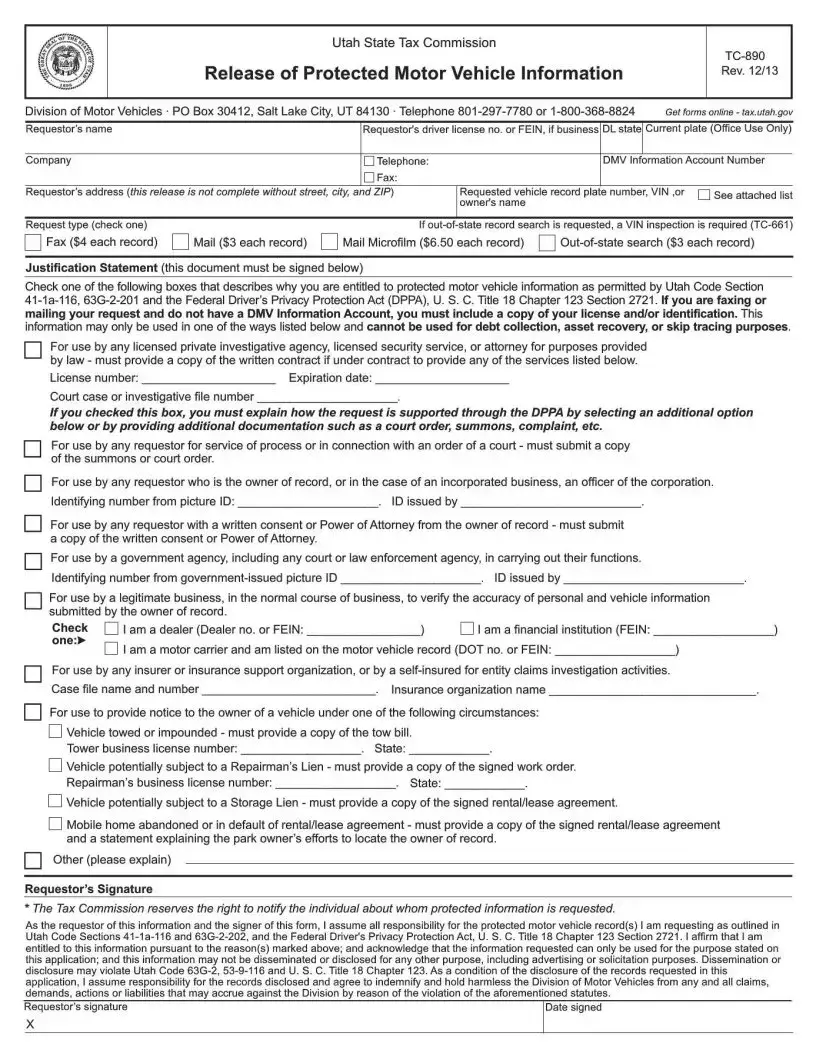The Utah TC-890 form, primarily used for vehicle title and registration purposes, shares similarities with the Application for Title or Registration (Form REG 343) in California. Like the Utah form, the California REG 343 is used when individuals need to title and register a vehicle in the state. Both forms collect detailed information about the vehicle and its owner, including make, model, year, VIN (Vehicle Identification Number), and owner's personal information. Each form serves as a key document in establishing legal ownership and ensuring that vehicles are properly registered according to state laws.
Similarly, the Texas Application for Texas Title and/or Registration (Form 130-U) mirrors the Utah TC-890 form's objectives. It's a comprehensive form used for titling and registering vehicles within Texas. The essential information required includes vehicle identification details and owner information, closely paralleling the Utah form's data requirements. Additionally, both forms play a crucial role in documenting the transfer of ownership and facilitating the collection of state-specific taxes and fees related to vehicle registration.
Florida’s Application for Certificate of Title With/Without Registration (Form HSMV 82040) also has many parallels with Utah's TC-890. This document is vital for Floridians needing to establish vehicle ownership and register vehicles. The form captures vehicle details, owner information, and lienholder information if applicable, much like the Utah form. It ensures that all vehicles meet Florida's regulatory requirements for title and registration, serving a similar regulatory role as the TC-890 form in Utah.
New York State's Vehicle Registration/Title Application (Form MV-82) bears similarities to the TC-890 form, serving as the primary document for titling and registering vehicles in New York. The information collected includes owner's personal data, vehicle specifics, and insurance details, which are crucial for title transfer and registration processes. Both forms facilitate the legal documentation of vehicle ownership and use within their respective states, adhering to state-specific regulatory frameworks.
In Pennsylvania, the Application for Certificate of Title (Form MV-1) shares objectives with the Utah TC-890 form. It's used for titling new, used, or out-of-state vehicles, collecting an array of information crucial for ownership documentation and vehicle registration. The Pennsylvania form, like its Utah counterpart, is a cornerstone document for establishing legal ownership and compliance with state vehicle registration laws.
Oregon’s Application for Title and Registration (Form 735-226) parallels the TC-890 form’s purpose and content requirements. This form is essential for those in Oregon needing to title and register a vehicle, capturing similar data on vehicle identity and ownership. Both forms are integral to the process of legalizing vehicle ownership and ensuring compliance with state-specific requirements for vehicle registration.
Michigan's Application for Michigan Vehicle Title (Form TR-11L) has objectives akin to those of the Utah TC-890, with both forms serving as crucial documents for the titling and registration process within their respective states. The form requires information about the vehicle, its purchase, and its ownership, similar to the data captured by the TC-890 form. It’s instrumental in the transition of ownership and the formalization of vehicle registration under state law.
In Illinois, the Application for Vehicle Transaction(s) (Form VSD 190) is used for various vehicle-related transactions, including titling and registration, similar to what the TC-890 accomplishes in Utah. The form's design to facilitate multiple vehicle transactions makes it a versatile document, much like the Utah form, ensuring compliance with state laws and regulations regarding vehicle ownership and registration.
Washington State’s Vehicle Title Application (Form TD-420-001) also shares similarities with Utah's TC-890 form. It's another essential document needed to title and register a vehicle in Washington, requiring detailed information about the vehicle and its owner. Both forms are foundational in establishing legal vehicle ownership and ensuring that all vehicles are registered accordingly within their respective states.
Lastly, the Application for Certificate of Title for a Vehicle (Form MV-1) in Wisconsin shares a similar function with the TC-890 form. Utilized for titling vehicles within Wisconsin, it collects comprehensive information on the vehicle and its owner, facilitating the proper documentation and registration of vehicles. Like the Utah form, it serves as a critical document in the state’s vehicle registration process, ensuring legal compliance and ownership documentation.
